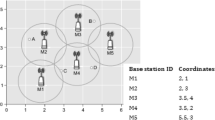Abstract
Power consumption is an interesting challenge to prolong the operational lifetime on IEEE 802.15/ZigBee Sensor Network (ZSN). ZigBee routers closer to the ZigBee coordinator (ZC) have a larger forwarding traffic burden and consume more energy than devices further away from the ZC. The whole operational lifetime of ZSN is deteriorated because of such an uneven node power consumption patterns, leading to what is known as an energy hole problem (EHP) around the ZC. In this article the average load traffic pattern for the ZSN has been explored and derived in terms of closed-form mathematical expressions. Also we propose a novel power-saving scheme to alleviate the EHP based on the N-policy M/G/1 queuing model. Having a counter (N) that controls the triggering radio server can reduce power consumption of a generic node. With little management cost, the proposed queue-based power-saving technique can be applied to prolong the lifetime of sensor network economically and effectively. For the proposed queue-based model, mathematical framework on performance measures has been formulated. Focusing on ZigBee routers deployed at the innermost shell of ZSN, numerical and network simulation results validate that the proposed approach indeed provides a feasibly cost-effective approach for lifetime elongation of wireless sensor networks.












Similar content being viewed by others
References
Akyilidiz IF et al (2002) Wireless sensor networks: a survey. Comput Netw 38(4):393–422
Ahuja SP, Myers JR (2006) A survey on wireless grid computing. J Supercomput 37:3–21
Liu M, Cao J, Zheng Y (2008) An energy-efficient protocol for data gathering and aggregation in wireless sensor networks. J Supercomput 43:107–125
Lai C-F, Huang Y-M, Chao H-C (2010) A context-aware multi-model remote controller for electronic home devices. J Supercomput 54:43–60
IEEE 802.15.4 Standard (2003) Part 15.4: wireless medium access control (MAC) and physical layer (PHY) specifications for low-rate wireless personal area networks. IEEE-SA Standards Board
Zigbee Specification (2006) Zigbee Alliance. Available online at: http://www.zigbee.org
Baronti P, Pillaia P, Chooks VWC, Chessa S, Gottab A, Fun Hua Y (2007) Wireless sensor networks: a survey on the state of the art and the 802.15.4 and Zigbee standards. Comput Commun 30:1655–1695
Li J, Mohapatra P (2005) An analytical model on the energy hole problem in many-to-one sensor networks. In: Proc of IEEE VTC Fall 2005, Dallas, TX
Lian J et al (2006) Data capacity improvement of wireless sensor networks using non-uniform sensor distribution. Int. J. Distrib. Sens. Netw. 2(2):121–145
Wadaa A et al (2005) Training a sensor networks. Mob Netw Appl, 10:151–168
Wang K-H, Wang T-Y, Pearn W-L (2007) Optimal control of the N policy M/G/1 queuing system with server breakdowns and general startup times. Appl Math Model 31(10):2199–2212
IEEE, Wireless LAN medium control (MAC) and physical layer (PHY) specification. IEEE Std. 802.11-1999 edition (R2003)
Ye W, Heidemann J, Estrin D (2002) An energy efficient MAC protocol for wireless sensor networks. In: Proc IEEE INFOCOM, pp 1567–1576
Polastre J, Hill J, Culler D (2004) Versatile low power media for wireless sensor networks. In: Proc ACM SenSys, pp 3–5
Schurgers C, Tsiatsis V, Srivastava M (2002) STEM: topology management for energy efficient sensor networks. IEEE Aerosp. Conf. Proc. 3:1099–1108
Meier A, Woehrle M, Zimmerling M, Thiele L (2010) ZeroCal: automatic MAC protocol calibration. In: Proc 6th IEEE int’l conference on distributed computing in sensor systems (DCOSS 2010), pp 31–44
Miller MJ, Vaidya NH (2005) A MAC protocol to reduce sensor network energy consumption using a wakeup radio. IEEE Trans Mob Comput 4(3):228–242
Kounev S (2006) Performance modeling and evaluation of distributed component-based systems using queuing Petri nets. IEEE Trans Softw Eng 32(7):486–502
The Network Simulator Ns2 (2010) Available at: http://www.isi.edu/nsnam/ns/
Kliazovich D, Bouvry P, Khan SU (2010) GreenCloud: a packet-level simulator of energy-aware cloud computing data centers. J Supercomput. doi:10.1007/s11227-010-0504-1
Acknowledgements
This study was supported in part by the National Science Council, Taiwan, R.O.C., under Grant Nos. NSC 100-2220-E-029-004 and NSC 100-2622-E-029-008-CC3.
Author information
Authors and Affiliations
Corresponding author
Rights and permissions
About this article
Cite this article
Jiang, FC., Wu, HW. & Yang, CT. Traffic load analysis and its application to enhancing longevity on IEEE 802.15.4/ZigBee Sensor Network. J Supercomput 62, 895–915 (2012). https://doi.org/10.1007/s11227-012-0759-9
Published:
Issue Date:
DOI: https://doi.org/10.1007/s11227-012-0759-9




